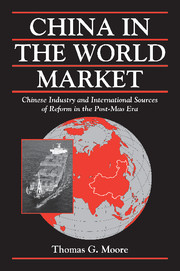Book contents
- Frontmatter
- Contents
- List of Figures
- List of Abbreviations
- Preface
- 1 China as a Latecomer in World Industrial Markets
- 2 The Outside World as an Impetus for Change in China
- 3 Tailor to the World: China's Emergence as a Global Power in Textiles
- 4 Beating the System with Industrial Restructuring: China's Response to the Multifiber Arrangement (MFA)
- 5 China Looms Large: Reform and Rationalization in the Textile Industry
- 6 Industrial Change in the Shadow of the MFA: The Role of Top-Level Strategy, Mid-Level Intervention, and Low-Level Demand in China's Textile Industry
- 7 Chinese Shipbuilding: The Modest Origins of an Emerging Industrial Giant
- 8 Dangerous Currents: Navigating Boom and Bust Cycles in International Shipbuilding
- 9 Chinese Shipbuilding and Global Surplus Capacity: Making a Virtue out of Necessity
- 10 Market-Oriented Solutions for Industrial Adjustment: The Changing Pattern of State Intervention in Chinese Shipbuilding
- 11 Who Did What to Whom?: Making Sense of the Reform Process in China's Shipbuilding Industry
- 12 External Shocks, State Capacity, and National Responses for Economic Adjustment: Explaining Industrial Change in China
- 13 China in the Contemporary International Political Economy
- Appendix Contours of the Research Effort
- Bibliography
- Index
9 - Chinese Shipbuilding and Global Surplus Capacity: Making a Virtue out of Necessity
Published online by Cambridge University Press: 07 August 2009
- Frontmatter
- Contents
- List of Figures
- List of Abbreviations
- Preface
- 1 China as a Latecomer in World Industrial Markets
- 2 The Outside World as an Impetus for Change in China
- 3 Tailor to the World: China's Emergence as a Global Power in Textiles
- 4 Beating the System with Industrial Restructuring: China's Response to the Multifiber Arrangement (MFA)
- 5 China Looms Large: Reform and Rationalization in the Textile Industry
- 6 Industrial Change in the Shadow of the MFA: The Role of Top-Level Strategy, Mid-Level Intervention, and Low-Level Demand in China's Textile Industry
- 7 Chinese Shipbuilding: The Modest Origins of an Emerging Industrial Giant
- 8 Dangerous Currents: Navigating Boom and Bust Cycles in International Shipbuilding
- 9 Chinese Shipbuilding and Global Surplus Capacity: Making a Virtue out of Necessity
- 10 Market-Oriented Solutions for Industrial Adjustment: The Changing Pattern of State Intervention in Chinese Shipbuilding
- 11 Who Did What to Whom?: Making Sense of the Reform Process in China's Shipbuilding Industry
- 12 External Shocks, State Capacity, and National Responses for Economic Adjustment: Explaining Industrial Change in China
- 13 China in the Contemporary International Political Economy
- Appendix Contours of the Research Effort
- Bibliography
- Index
Summary
DIVERSIFYING THE PRODUCT MIX: THE MOVE UPMARKET IN SHIPS
While Chinese yards had long built a variety of ships, the impact of the global shipbuilding recession on CSSC's product mix for export was unmistakable. As the market for basic ships deteriorated during the mid-1980s, especially the demand for bulk carriers, China quickly came to export mostly advanced ships. (Following convention, this study classifies advanced ships as all vessels except bulk carriers and basic tankers.) Indeed, the share of advanced ships among China's exports increased from 56 percent to 85 percent from the first half to the second half of the 1980s. While impressive in its own right, this jump actually understates the shift upmarket from basic ship types since the “advanced ships” exported by CSSC from 1980 to 1984 were, in fact, lower-end multipurpose and multipurpose-container ships. Although categorized here as advanced ships for the sake of analytical consistency, these relatively unsophisticated vessels artificially inflated the share of advanced ships in China's product mix during the first half of the decade.
By contrast, the advanced ship category for the second half of the decade included a growing range of truly high-end vessels. Indeed, it was from 1985 to 1989 that China first began to build ultramodern containerships and partial containerships, including a number of refrigerated carriers. Among this last group, the real milestone for Chinese shipbuilding came in April 1987 when Hapag-Lloyd, the German shipping giant, awarded CSSC a much coveted contract for the Berlin Express, a 32,800-deadweight-ton refrigerated containership.
- Type
- Chapter
- Information
- China in the World MarketChinese Industry and International Sources of Reform in the Post-Mao Era, pp. 217 - 237Publisher: Cambridge University PressPrint publication year: 2002

